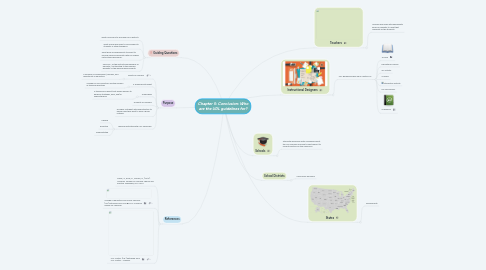Chapter 5: Conclusion: Who are the UDL guidelines for?
by Kaitlyn Ray


1. Guiding Questions
1.1. What curriculum to purchase for a district?
1.2. What online resources to recommend to students or other teachers?
1.3. What kinds of assessments to select to provide valid and accurate data for making instructional decisions?
1.4. How am I, as the instructional designer or educator, contributing to the learning disability of the learning environment?
2. Purpose
2.1. Equity of Learners
2.1.1. A measure of achievement, fairness, and opportunity in education
2.2. A learning instrument
2.2.1. A guide for self-reflection and the revision of teaching practices
2.3. Scaffolding
2.3.1. A temporary support that allows learners to develop strategies, skills, and/or understanding.
2.4. Diversity of Learners
2.5. Provides a student with opportunities to decide how they want to learn a given material.
2.6. Learning activities with UDL should be:
2.6.1. Flexible
2.6.2. Effective
2.6.3. Differentiated
3. References
3.1. Meyer, A., Rose, D., Gordon, D., (2014). Universal Design for Learning: Theory and Practice. Wakefield, MA: CAST.
3.2. College of Education and Social Services. (n.d.) Retrieved from UDL@UVM: Universal Design for Learning
3.3. UDL Center. (n.d.) Retrieved from UDL Center – Medium
4. Instructional Designers
4.1. UDL guidelines help aid in creation of:
4.1.1. A book
4.1.2. Educational Games
4.1.3. An Activity
4.1.4. A lesson
4.1.5. Interactive Activity
4.1.6. Full curriculums
4.1.7. A resource
